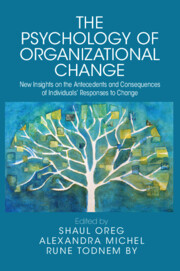 The Psychology of Organizational Change
The Psychology of Organizational Change A Review and Directions for Future Research
from Part II - The Evolution of Change and Its Responses
Published online by Cambridge University Press: 28 September 2023
We focus on change recipients’ emotional responses to organizational change. We identify the key theoretical frameworks that have been used to consider recipients’ emotional reactions to change. Our review reveals a focus on appraisal theories of emotions, although other theoretical perspectives have been adopted, including affective events theory (AET) and the broaden and build theory of positive emotions. We argue, however, that other dominant theories, including emotion regulation theories and emotional contagion, have not received adequate attention in the change field. Our review identifies four key foci of empirical research, including efforts to (1) understand the structure of change recipients’ emotional responses to change, (2) develop process models of emotional responses to change, (3) explore the antecedents and outcomes of emotional responses to change, and (4) consider the influence of change recipient and leader emotional intelligence on change outcomes. We develop an integrative framework that provides a conceptual map of relevant concepts when studying change recipients’ emotional responses to change. We conclude with identifying future directions for research.
To save this book to your Kindle, first ensure no-reply@cambridge.org is added to your Approved Personal Document E-mail List under your Personal Document Settings on the Manage Your Content and Devices page of your Amazon account. Then enter the ‘name’ part of your Kindle email address below. Find out more about saving to your Kindle.
Note you can select to save to either the @free.kindle.com or @kindle.com variations. ‘@free.kindle.com’ emails are free but can only be saved to your device when it is connected to wi-fi. ‘@kindle.com’ emails can be delivered even when you are not connected to wi-fi, but note that service fees apply.
Find out more about the Kindle Personal Document Service.
To save content items to your account, please confirm that you agree to abide by our usage policies. If this is the first time you use this feature, you will be asked to authorise Cambridge Core to connect with your account. Find out more about saving content to Dropbox.
To save content items to your account, please confirm that you agree to abide by our usage policies. If this is the first time you use this feature, you will be asked to authorise Cambridge Core to connect with your account. Find out more about saving content to Google Drive.